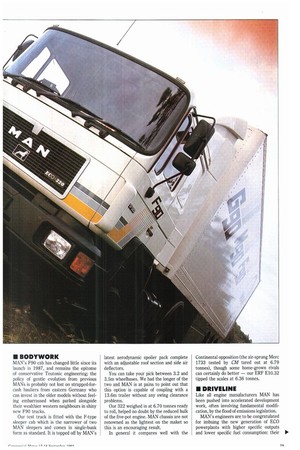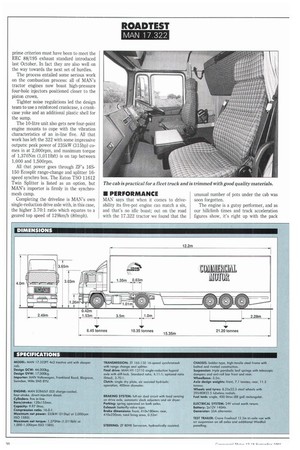F A lla i F IVE ?
Page 30

Page 31

Page 32

Page 33

If you've noticed an error in this article please click here to report it so we can fix it.
Conservative operators might be put off by a five-cylinder engine; but the diesel in MAN's latest fleet tractor is the willing heart of a productive contender.
• Getting more from less is an appealing idea for transport engineers striving to get the best out of their fleets, and MAN's new 17.322 makes a virtue out of providing less than the opposition.
It relies on a five-cylinder engine in a sector where the six is king, yet MAN claims that its performance is more than a match for its rivals.
MAN's latest fleet fighter forms a vital part of the revised F90 tractor family which debuted at last autumn's NEC show, complete with trendy green ECO badges on their grilles. The ECO badges draw attention to MAN's success in reducing exhaust emissions, but while that may be what grabbed the headlines, the entire range of five, six and 10-cylinder charge-cooled diesels also feature higher power outputs.
As a result the 10-litre five from the .262 was re-rated for service in the .272 and the .322, while the 12-litre six moved upmarket to power the .372 and the .422. Similarly, the mighty 18-litre vee-10 flexed its muscles to become the .502 — and very nice it is too, as our recent Continental test showed (CM 20-26 June ).
So it's goodbye to the .292 and .332 sixes, and welcome to the 17.322. Its task will certainly not be an easy one, for the competition in the fleet market around 240kW (320hp) is intense, with plenty of well-established machines to tempt conservative buyers away from the five-pot MAN. Two obvious contenders are the Volvo FL10 and ERF E10.32; then there are the L10 Cummins-powered trucks from Foden and Seddon Atkinson, the new Leyland Daf Series 80, Merc's 1733 and the Scania P113... it all adds up to a pretty long shortlist.
Undeterred, MAN is stressing the benefits of a five-pot over a six, including compact dimensions, low weight, reduced internal friction losses and fewer parts to maintain. All in all, the newcomer will not be easily dismissed.
• BODYWORK
MAN's F90 cab has changed little since its launch in 1987, and remains the epitome of conservative Teutonic engineering; the policy of gentle evolution from previous MANs is probably not lost on strapped-forcash hauliers from eastern Germany who can invest in the older models without feeling embarrassed when parked alongside their wealthier western neighbours in shiny new F90 trucks.
Our test truck is fitted with the F-type sleeper cab which is the narrower of two MAN sleepers and comes in single-bunk form as standard. It is topped off by MAN's latest aerodynamic spoiler pack complete with an adjustable roof section and side air deflectors.
You can take your pick between 3.2 and 3.5m wheelbases. We had the longer of the two and MAN is at pains to point out that this option is capable of coupling with a 13.6m trailer without any swing clearance problems, Our 322 weighed in at 6.70 tonnes ready to roll, helped no doubt by the reduced bulk of the five-pot engine. MAN chassis are not renowned as the lightest on the maket so this is an encouraging result.
In general it compares well with the Continental opposition (the air-sprung Merc 1733 tested by CM tared out at 6.79 tonnes), though some home-grown rivals can certainly do better — our ERF E10.32 tipped the scales at 6.36 tonnes.
• DRIVELINE
Like all engine manufacturers MAN has been pushed into accelerated development work, often involving fundamental modification, by the flood of emissions legislation.
MAN's engineers are to be congratulated for imbuing the new generation of ECO powerplants with higher specific outputs and lower specific fuel consumption: their 1111. prime criterion must have been to meet the EEC 88/195 exhaust standard introduced last October. In fact they are also well on the way towards the next set of hurdles.
The process entailed some serious work on the combustion process: all of MAN's tractor engines now boast high-pressure four-hole injectors positioned closer to the piston crown.
Tighter noise regulations led the design team to use a reinforced crankcase, a crankcase yoke and an additional plastic shell for the sump.
The 10-litre unit also gets new four-point engine mounts to cope with the vibration characteristics of an in-line five. All that work has left the 322 with some impressive outputs: peak power of 235kW (315hp) comes in at 2,000rpm, and maximum torque of 1,370Nm (1,0111bft) is on tap between 1,000 and 1,500rpm.
All that power goes through ZF's 16S150 Ecosplit range-change and splitter 16speed synchro box. The Eaton TS0 11612 Twin Splitter is listed as an option, but MAN's importer is firmly in the synchromesh camp.
Completing the driveline is MAN's own single-reduction drive axle with, in this case, the higher 3.70:1 ratio which equates to a geared top speed of 129km/h (80mph).
• PERFORMANCE
MAN says that when it comes to driveability its five-pot engine can match a six, and that's no idle boast; out on the road with the 17.322 tractor we found that the unusual number of pots under the cab was soon forgotten.
The engine is a gutsy performer, and as our hillclimb times and track acceleration figures show, it's right up with the pack when the driver needs to get a move on.
On motorway drags it clings on willingly at around 1,400rpm; if the revs begin to drop further a swift split change picks up some 300rpm and keeps the motor working at its best in the solid green band in the rev counter.
Although the torque curve is nominally flat down to 1,000rpm this is no great lugger and there is no point hanging on below 1,200; beneath this point momentum is quickly lost and the engine begins to rumble uncomfortably on its mountings. This was one of the few times that we were aware of engine noise; our noise reading of 71.5dB(A) at the motorway limit is particularly impressive for a fleet machine.
Driver comfort on main roads was also helped by a Lucas Kienzle limiter with cruise control which MAN fits as standard with the faster rear axle. We found the system easy to use and made use of it where conditions allowed. ZF's 16-speed box works well in the MAN; we liked its choice of ratios and easily taken splits, but remain unconvinced of the benefits of the double-H layout in a modern truck and would prefer to see a single H with the range-change on a switch or collar as used on the Leyland Daf 95 Series. This would facilitate fast changes to low-range and would also allow a more compact gate for the gearchange at the moment the gear lever sticks into the driver's left leg when in top gear. We're surprised that MAN made such a basic oversight when converting the 322 to right-hand drive.
On the subject of gear-lever gripes, why didn't they fit a buzzer to warn against selection of low-range at too high a speed?
To most other respects the MAN is very much a driver's machine. It steers well, corners well and copes with road irregularities confidently for a steel-suspended truck. Mind you, the brakes could have done with a bit more bite: they were adequate for routine braking on the road, but for sustained downhill decents and particularly during all-out track testing they lacked power.
A typical figure for maximum braking force is 0.7g; the best we could manage with the 322 was 0.55g with no trace of locking.
MAN blames poor adjustment on its trailer, which we used because our Crane Fruehauf curtainsider was not available.
• ECONOMY
The semi-trailer supplied by MAN was also a Crane Fruehauf, but with a box body and some additional Windfoil panelling. What effect this had on fuel consumption is In-cab storage is supplemented by two lockable exterior cabinets which are handy for tools, ropes and emergency equipment.
























































































